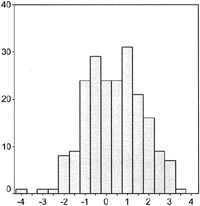Introduction
The primary goal of this paediatric subproject is to identify candidate genes for the leanness associated with constitutional delay of growth and puberty (CDGP; 1). CDGP – a variant of normal development in otherwise healthy children – is a disorder, for which paediatric patients most frequently consult an endocrine unit. Children affected with CDGP are characterized by short stature, bone age retardation and delayed puberty. Within NGFN1 we were able to demonstrate that CDGP represents a specific form of underweight and therefore contributes to the lower end of the distribution of body weight. Children with CDGP in many ways have a phenotype which contrasts that observed in obese children: Bone maturation and puberty are delayed in CDGP as opposed to advanced in obesity; CDGP children are frequently poor eaters in contrast to obese children. In NGFN1, the clinical, endocrine and molecular characterization of the to our knowledge worldwide first sample of sib-pairs affected with this common paediatric disorder was initiated. CDGP has so far been neglected in clinical and genetic research. The size of our unique cohort of families affected with CDGP will be increased and concomitantly clinical, behavioural and endocrine characterization of these patients will be continued. Genetic studies (confirmation and fine-mapping of linkage peaks from a genome scan) should eventually lead to the identification of alleles/genes underlying CDGP. With the recent advent of new radio-immunoassays for the determination of total and active ghrelin, promising new insights into the endocrine mechanisms of satiety regulation in CDGP will be feasible. A genome scan – the to our knowledge first for this disorder - has just recently been performed; At least two promising peaks in genomic regions of interest were detected (Dempfle et al., in preparation): one on chromosome 12 with a nonparametric LOD score of about 2.5 in a region that has already been implicated in recent linkage genome scans of adult height and one peak on chromosome 15 (LOD ~ 1.5) in the Prader-Willy-Syndrome (PWS) region. This is especially interesting since an important feature of PWS is also short stature. The availability of genomic material from our unique cohort of CDGP children has led to productive cooperations. In collaboration with Prof. Hebebrand (Essen) studies concerning identification of several sequence variants of the ghrelin receptor gene in obese and healthy subjects as well as in children with CDGP have been undertaken (2). In children with idiopathic short stature (ISS), studies investigating body mass index (BMI) or parameters of satiety regulation are scarce, and studies analyzing eating behaviour are lacking.
Results
In addition to the 274 children (154 index and 91 siblings) with ISS from 154 families that had been ascertained already, 21 novel families have been recruited, 23 more are willing to participate. Affected children had to have a body height <5th percentile, or, in the case of siblings, the body height of 1 child had to be <5th percentile and the other <15th percentile. Medical histories were recorded by using structured and standardized interviews. Eating behaviour was assessed by using the Child Eating Behaviour Questionnaire (CEBQ). Percent energy intake as fat was assessed by using the Leeds Food Frequency Questionnaire. To build up an endocrine profile, haemogram, blood glucose, creatinine, prolactine, glutamic oxalacetic transminase (GOT), gamma-glutamyl-transferase (GGT), alkaline phosphatase (APH), C-reactive Protein (CRP), erythrocyte sedimentation rate (BSG), Immunoglobuline A + G (IgA/IgG), thyroidea stimulating hormone (TSH) and Thyroxine (T4) were ascertained. Additionally, endocrine markers of body weight regulation like leptin, ghrelin, insulin-like growth factor 1 and insulin-like growth factor binding protein 3 were determined in serum. Urine status and cortisol are ascertained via 24-hour urine. Included anthropometric parameters are body weight and height, seat height, span and head circumference. Bone age was independently assessed by three pediatric radiologists from X-ray films of the left hand. Bone age determination was performed blinded for the patients' birth date and the mean of three ratings for each radiograph was used.
A first sample of 214 children included 56 cases (26.2%) with a bone-age delay of >1 year, 43 cases (20.1%) of FSS, 92 cases (43.0%) with a combination of both conditions, and 23 cases (10.7%) without pronounced bone-age retardation and with normal target height. With respect to gender distribution, there was a striking imbalance in the group of index patients, with a majority of almost two thirds being male gender, whereas no difference could be found among siblings. Additionally, body height was considerably lower, by almost 1 SDS, in index patients. Bone-age retardation was clearly more pronounced in index patients compared with their siblings. Table 1 summarizes the data pertainig to the characterization of eating behaviour in our patients with ISS. Initially, we compared the scores from the CEBQ with reference data from the literature (4). The complete group of patients showed a different behaviour from the reference sample in some respects. When divided into the 2 groups of good and poor eaters, poor eaters clearly revealed lower food responsiveness, higher satiety responsiveness, decreased enjoyment of food, and increased fussiness over food and were slower eaters. The mean BMI SDS of -0.33 in the whole sample corresponds to the 37th population percentile. Both good and poor eaters had mean BMI SDS values below the respective reference values, and the BMI SDS was significantly lower in the group of poor eaters. Height differed significantly between the 2 subgroups: poor eaters had a markedly lower body height. BMI SDS was not correlated significantly with chronological age. In the overall group of children with ISS, serum concentrations of IGF-I were lower than population population norms (mean SDS: –1.0; P < .001), whereas serum concentrations of IGFBP-3 were somewhat higher (mean SDS: +0.3; P < .001). Leptin levels, adjusted for gender, BMI, and pubertal development, were significantly higher in the whole group than for population norms (mean SDS: +0.39; P < .001). Serum levels of ghrelin could not be compared with population data, because no reference values were available for the test kit. The differences between good and poor eaters were not significant for any of the endocrinologic parameters.

An overall comparison of our total sample of children with reference ranges in the literature (Wardle et al. 2001) revealed distinct differences in several aspects of eating.
Responsiveness to food was clearly reduced in our patients, who did not seem to enjoy food as much as unaffected children; they had a reduced desire to drink and tended to eat less during negative emotional states. Additionally, our patients were somewhat more fussy ("picky") eaters, in that they were highly selective about the range of foods accepted. All these altered parameters of eating behavior are in keeping with a specific behavioral pattern of eating style and, therefore, allowed characterization of this sample of children as poor eaters. It has been suggested that suboptimal nutrition in childhood can lead to impaired development of body height. Indeed, we found that poor eaters had a significantly lower height than the good eaters. Therefore, one could speculate that the poor eating behavior found in our patients might lead to suboptimal nutrition and could contribute to their short stature and developmental delay. On the other hand, it cannot be excluded that slow growth and development cause impaired drive for eating as long as energy stores are sufficiently replete. Therefore, the question of what comes first, reduced energy intake or slow growth, remains open. The findings of an altered eating behavior and reduced BMI in children with ISS caused us to investigate further the role of two important regulators of satiety, leptin and ghrelin. Leptin acts on the hypothalamus, suppressing food intake, stimulating energy expenditure and seems to play a significant role in the initiation and progression of puberty. We calculated leptin SDS, adjusted for gender, BMI, and Tanner stage according to reference data (Fig 1; 5). Among all children, we found that 13% had a leptin SDS >1.96, compared with 5% expected from a general population sample. It was unexpected that patients with ISS have relatively high leptin levels for their BMI, a fact that may indicate alterations in endocrine mechanisms of satiety regulation in parallel to the observed altered eating behaviour. Ghrelin is a potent growth hormone secretagogue that exerts strong orexigenic effects. Similar to leptin, total ghrelin did not show any differences between poor and good eaters. Our clinical, behavioral, and endocrinologic findings in patients with ISS point to an altered eating behavior that possibly contributes to their short stature. (3).

In conclusion, NGFN1 and 2 have permitted to lay the foundations for research regarding phenotypic and genotypic characterization of the so far neglected common pediatric disorder of CDGP/ISS. On an international level, NGFN1 and 2 had allowed us to build up a valuable sample and to perform the first genome scan for this disorder. We demonstrated that CDGP presents a highly interesting and challenging human model for underweight, delayed bone maturation, reduced stature and poor eating behaviour.
Outlook
Idiopathic short stature (ISS) in childhood is a common cause for referral to pediatric endocrinologists. We aim to identify genetic regions linked to ISS, through a whole genome scan in 92 families each with two affected children with ISS. Linkage analysis was performed for the affection status ISS and the quantitative traits height, bone age retardation and body mass index (BMI). Chromosome 12 showed significant evidence of linkage to ISS and height (maximum non-parametric multipoint LOD scores 3.18 and 2.31), especially in sister-sister pairs. These traits were also linked to chromosomes 1 and 2. Bone age retardation showed moderate linkage to chromosomes 19 and 7 (LOD scores 1.69 and 1.42). Moderate linkage to BMI was detected on chromosomes 2 and 13 (1.32 and 1.27). The same region on chromosome 12 was previously linked to adult stature in several genome scans and harbours the vitamin D receptor, which has been associated with variation in height in children and adults (Dempfle et al., in preparation). Further work will be required to confirm the linkage chromosomal regions for ISS in new independent samples and to test associations of positional candidate genes.
Lit.: 1. Bierich JR. Constitutional delay of growth and adolescence. CEM 1992; 6(3):573-88. 2. Wang HJ et al. Ghrelin receptor gene: identification of several sequence variants in extremely obese children and adolescents, healthy normal-weight and underweight students, and children with short normal stature.JCEM 2004; 89(1):157-62. 3. Wudy SA et al. Children with idiopathic short stature are poor eaters and have decreased body mass index. Pediatrics. 2005;3. 116(1):e52-7. 4. Wardle J. Development of the Children's Eating Behaviour Questionnaire. JCPP 2001; 42 :963 – 970. 5. Blum WF et al. Plasma leptin levels in healthy children and adolescents: dependence on body mass index, body fat mass, gender, pubertal stage, and testosterone. JCEM 1997; 82 :2904 –2910.


